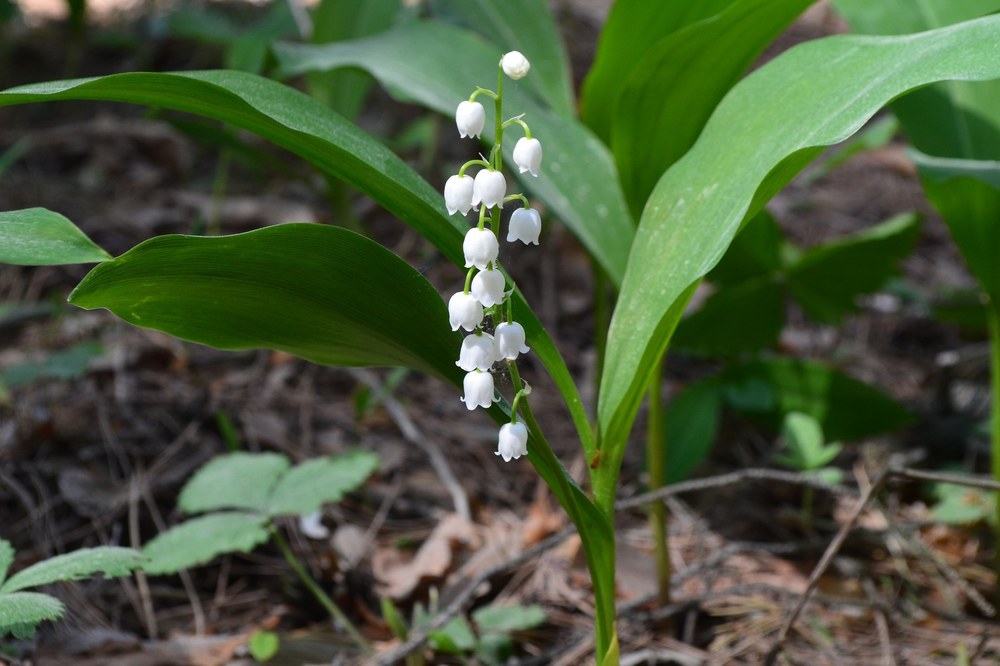Posted: May 5, 2021
After a cold and dreary winter, spring emerges and brings us an atmosphere of beautiful colors, melodic sounds, and sweet scents. One of the most fragrant of these scents belongs to May’s Birth Flower, Lily of the Valley.

Lily of the Valley, photo from Pixabay
The Old Farmer's Almanac and other sources of folklore indicate that the lily of the valley is associated with many meanings, based on many cultures and time periods. People of the 1800's Victorian Era believed that lily of the valley meant a "return to happiness." Learning and understanding special symbolism for flowers was a popular pastime in the Victorian Era. Nearly all Victorian homes had, alongside the Bible, guidebooks for interpreting this unspoken language.
There is a language, little known,
Lovers claim it as their own.
Its symbols smile upon the land,
Wrought by nature's wondrous hand;
And in their silent beauty speak,
Of life and joy, to those who seek
For Love Divine and sunny hours
In the language of the flowers.
-The Language of Flowers, London, 1875
The Victorian Era was only one of many eras that "spoke with flowers." Over the centuries, the lily of the valley has developed many meanings. According to ancient astrology, this flower was under the protection of the son of the goddess Maia. For the Greeks, this god was Hermes and for the Romans it was Mercury. Another legend tells of a lily of the valley who fell in love with a nightingale's song, so it bloomed only when the bird returned to the woods in May.
The flower is also known as the May lily, May bells, or French "Muguet des bois." The scientific name is Convallaria majalis. The genus name means "valley" and the species name means "belonging to Maia" since May is its month of flowering.
The fragrant white flowers have been associated with motherhood, chastity, and sweetness. In Germanic mythology, lily of the valley flowers have been associated with the humility and purity of the virgin goddess Ostara. In Christian legend, Eve's tears turned into lilies of the valley as she was expelled from the Garden of Eden. The flower is also seen as a sign of Christ's second coming and is mentioned fifteen times in the Bible.
While the lily of the valley is most popular as a perennial garden plant, it is increasing in popularity as a cut flower, most often in bridal bouquets. The flower's traditional symbolism of purity, humility, and virtue adds to its popularity in wedding arrangements. Its beautiful fragrance has inspired perfumes and beauty products. Despite the name, lily of the valley is in the same plant family as asparagus and less closely related to lilies.
Lily of the valley is a low-maintenance groundcover that's hardy in Zones 2 to 7. It is native to Europe. In North America, it reproduces more often by naturalization. Plants grow 6 to 12 inches tall and each plant has two to three elliptic green leaves with a flowering stem rising from the center of each leaf clump. The stem bears a one-sided arrangement of five to ten bell-shaped, sweetly fragranced flowers which bloom in early to mid-spring for approximately three to four weeks. The plant needs cold weather for its best appearance, so is showiest in regions with colder winters, including Pennsylvania. Lily of the valley is primarily seen in white, but it can also be found in pink and lilac. Orange-red berries may appear in the fall with each berry containing one to six seeds.
Lily of the valley grows best in moist, fertile, organically rich, well-drained soils in part shade to full shade but can spread rapidly by rhizomes which are underground stems and it can become weedy, forming dense colonies in the landscape. It tolerates a wide range of soil conditions, including dry and clay soils but does not tolerate heat. Flowering may decrease over time, so dividing the plants in spring or fall by root division allows for easy propagation for additional plants. Lily of the valley is easy to cultivate and maintain, and it can be susceptible to disease under certain conditions. See the Penn State Extension article, Lily of the Valley (Convallaria) Diseases for more information.
Something that must be emphasized, however, is the serious toxicity of lily of the valley. Every part is poisonous -- roots, stems, leaves, flowers, and berries. The plant contains cardiac glycosides which can cause cardiac malfunction and distress. Deer, rabbits, voles, and other animals leave it alone which makes it an easy plant to cultivate, but it is important to keep children and pets from ingesting any part of it.
You may be enchanted by the impact of the beauty and aroma these tiny flowers bring to us in the spring. And if you want to show your loved ones that they make your life complete, a bouquet of lilies of the valley can deliver that message. So, even though the lily of the valley appears dainty and inviting, representing happiness, humility, and sweetness, it can be deceiving, and even dangerous.
~ by Joan Banyas, Penn State Master Gardener Trainee of Luzerne County

